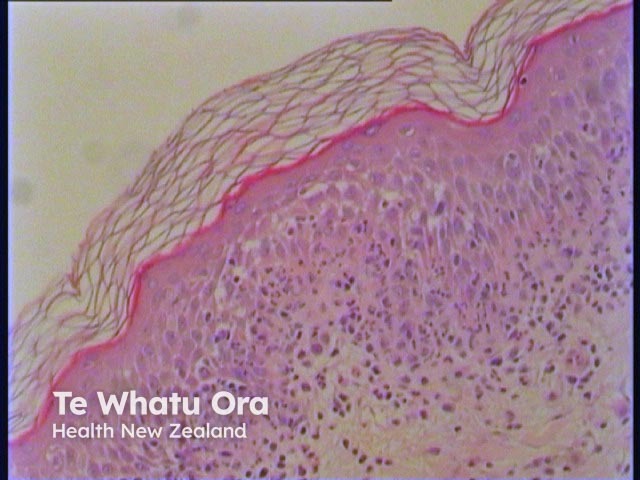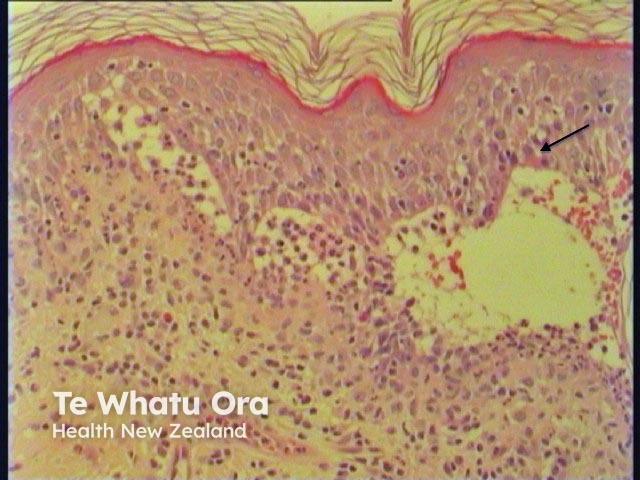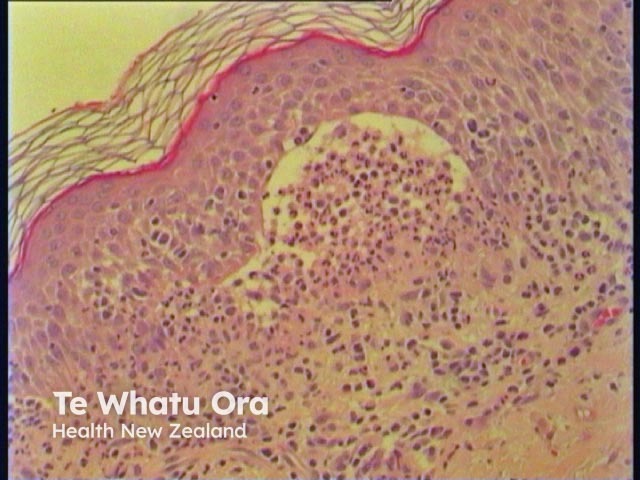Main menu
Common skin conditions

NEWS
Join DermNet PRO
Read more
Quick links
Toxic epidermal necrolysis pathology — extra information
Reactions Diagnosis and testing
Toxic epidermal necrolysis pathology
Author: Harriet Cheng (BHB, MBChB), Dermatology Unit, Waikato Hospital; Duncan Lamont, Pathologist, Waikato Hospital; A/Prof Patrick Emanuel, Dermatopathologist, Auckland, New Zealand, 2014.
Toxic epidermal necrolysis (TEN) is a severe cutaneous drug reaction characterised by a prodromal 'flu-like illness followed by the rapid appearance of a painful erythematous rash and desquamation of skin and mucous membranes. TEN is at the severe end of a spectrum with Stevens-Johnson syndrome defined by >30% body surface area skin detachment.
Histology of toxic epidermal necrolysis
In TEN, there are subepidermal bullae (Figures 1–3) with widespread epidermal necrosis and subsequent separation or loss of the entire epidermis. Apoptotic keratinocytes may be seen at the periphery (Figure 2, arrow). There is minimal inflammatory infiltrate.

Figure 1

Figure 2

Figure 3
Differential diagnosis of toxic epidermal necrolysis
Erythema multiforme: Apoptotic keratinocytes with less prominent necrosis (may be seen at the centre of established lesions), inflammatory infiltrate is more prominent with lymphocytic perivascular infiltrate.
Phytophototoxic reaction: Marked oedema and subepidermal blistering with apoptotic keratinocytes and epidermal necrosis. Minimal inflammatory infiltrate. Clinical features will easily differentiate from TEN.
Chemotherapy-induced acral erythema: If severe can progress to subepidermal blistering with epidermal necrosis. Clinically distinct from TEN.
Differential diagnosis of cell-poor subepidermal blistering includes variants of epidermolysis bullosa, porphyria cutanea tarda, cell-poor type bullous pemphigoid, burns, suction blisters and some bullous drug reactions.
References
- Dermatology (Third edition, 2012). Bolognia JL, Jorizzo JL, Schaffer JV
- Weedon’s Skin Pathology (Third edition, 2010). David Weedon
- Pathology of the Skin (Fourth edition, 2012). McKee PH, J. Calonje JE, Granter SR
On DermNet
- Stevens Johnson Syndrome – Toxic Epidermal Necrolysis
- Dermatopathological glossary
- Dermatopathology index
Books about skin diseases
